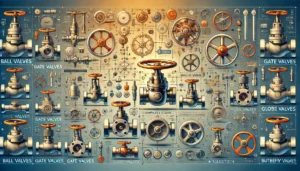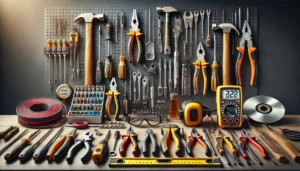“Selecting the right pipe fitting can be a turning point for enhancing the efficiency of industrial systems? It’s not merely a matter of connecting pipes but rather optimizing the flow of everything!”
Pipe fittings are critical to plumbing and piping systems. They are the silent enablers across industries. Starting from the extensive pipeline network in a manufacturing plant down to the simple plumbing in your house, pipe fittings are a necessity. They facilitate the movement of fluids, gasses and even solids in a safe and efficient manner, supporting many systems that are the backbone of the modern world.
In this blog, we will explore the world of pipe fittings deeply. We will cover the different types of fittings, their unmatched functions, and how they are utilized in different industries. If you happen to be a project engineer, maintenance specialist, or someone interested in how all the small contraptions work together to run the world, we hope this guide will equip you with new ideas and knowledge about pipe fittings and their interfaces.
Understanding Pipe Fittings
Pipe fittings are critical attachments for joining various lengths of pipe or tubing. They are essential for controlling the flow of substances into and out of pipelines, changing the flow direction, adjusting the pipe size, or stopping the flow in specific situations. In both industrial and residential settings, these fittings are extremely important because they allow systems to operate properly, safely, and without leaks.
Material Overview
The selection of the pipe fitting material is very important since it can change based on the application. Frequently selected materials include the following:
- Copper: Recognized for his great reliability and superb thermal conductivity, thus making him an excellent choice for heating systems.
- Steel: Strong and able to endure great pressures, making it the go-to in industrial applications.
- Brass: Famed for being corrosion resistant but also for his elegant appearance, making it ideal for both cover and concealed works.
- PVC (Polyvinyl Chloride): Known to be extremely popular in plumbing works of the house because of its resistance to tearing and corrosion.
- Iron (Ductile and Cast): Usually seen in the industrial sector where high pressure exists.
Choosing the right material to work with hinges on many factors like the type of fluid being transported, the pressure, environmental conditions and of course budget constraints. Each material brings its own set of advantages.
Types of Pipe Fittings and Their Applications
Pipe Elbows: For Precision Engineering In Directional Piping
Technical Description: When it comes to changing the direction of piping systems, plumbing elbows offer extremely accurate angles of 45° or 90°. These specific fittings maintain proper system pressure and flow for advanced piping systems, which is critical for maintaining system operability. They are designed to endure the mechanical stresses created by sharp or gradual direction changes. This makes the fittings essential for use in both low-pressure and high-pressure applications.
Advanced Applications: Elbows are indispensable tools for modular construction projects. They help in the routing of pipes through complex architectural designs, which helps manage space in urban areas or within advanced machinery. In manufacturing setups, elbows are used to design intricate yet efficient pipe layouts and allow processes that rely on a specific flow structure to operate smoothly. Their role in high-pressure systems like hydraulic and pneumatic networks are particularly critical as they assist in maintaining constant pressure and suppression of disturbances in the flow.
Industry Spotlight:
- In the construction industry, especially during the construction of high-rise and industrial buildings, elbows are used to repurpose space and to improve the efficiency of plumbing, gas, and heating systems.
- Elbows are used in the automotive and aerospace industries to devise compact systems for fluid transfer in machinery and equipment.
- In the geothermal energy and oil refinery sectors, elbows are used to contain piping directional shifts under severe conditions.
Nipples: Robust Connectors for Diverse Industrial Applications
Detailed Technical Overview: Nipples, which are short length pipes with external male threading, are designed to serve as strong and reliable joins in different piping systems. Their design allows for trouble-free joining and disassembly, which is convenient for maintenance and alteration. The tight seal made by the defined threads prevents leakages which transport dangerous or pressurized materials throughout a system.
Industrial Necessity:
- Nipples are vital for constructing highly pressurized piping networks that are resistant to harsh corrosive chemicals in the oil and gas industry. Nipples enable quick fastening of pipes and valves to each other.
- In HVAC, nipples are used to join secondary equipment to components for air as well as fluid movement in the system to avert loss of system integrity.
- In the petrochemical sector, they are working with the vast systems of pipes, which are essential for the safe movement of chemicals and gas.
Reducers: Streamlining Flow Dynamics in Varied Piping Systems
Every pipe system has to accommodate factors like seamless integration of distinct diameters within separators known as reducers. These will always prioritize the preservation of uniform flow, low pressure fluctuations, and avoidance of upsets due to sharp contractions in pipe sizes. There are two main types of reducers: concentric and eccentric. The differences in use lie mainly in the possibility of restricting air pockets or sedimentation.
Advanced Engineering Applications:
- From an engineering standpoint, structure design should focus on the chemical process industry. In chemical and petrochemical production, reducers are important in controlling the region of enhancement of fluids from large supply pipelines to smaller process pipelines. This is important for sustaining flow and limiting stress on the system.
- Remove every adjustable valve and screw in a water treatment plant for efficient water treatment. They are particularly important for ensuring perfect flow control during treatment with varying system component flow rates. Reducing the treatment time is not an option.
- For these plants, steam control valves need reducers at the asset side to align with the steam piping diameter escalation towards the turbine.
Sockets: Ensuring Seamless Connections in Uniform Diameter Pipes
A Comprehensive Technical Perspective: “Sockets” (or couplings) are fittings that allow for strong and tight connections between two pipes of the same diameter. They can adequately provide continuity in a piping system and the sockets are built to endure so many different stresses like thermal expansion, pressure fluctuations, and even environmental impacts. This ductility makes it reliable for piping alterations whether temporary or permanent.
Critical Industrial Roles.
- In HVAC systems, sockets serve the purpose of maintaining smooth, uninterrupted air, or fluid flow. They serve to join straight pieces of pipes or tubes thereby maximizing the efficiency of heating, cooling, and ventilation systems.
- In manufacturing, specifically in automated production lines, sockets are utilized in establishing dependable piping systems that deliver fluids or gases to machinery, thereby promoting warded operational disruption.
- In the water supply and water distribution sector, sockets maintain the integrity of the distribution network which serves to ensure optimal water flow, preventing water contamination.
Enhanced Technical Description: Doubtlessly, tees are remarkable devices for dividing one flow into two or combining two flows into one based on the system requirement. They are like the letter ‘T’ and come in various forms such as equal tees ( where all the three openings are of same diameter) and reducing tees ( where one of the outlets is of smaller diameter). Their shape is such that minimization of turbulence and smooth transition of flow, which is essential for pressure and efficiency, is maintained.
Advanced Engineering and Design Applications:
- In farms and in particular, in irrigation systems, tees are vital when it comes to dividing water across several channels. They are of fundamental importance when customizing an irrigation scheme to fit a certain land topography and crop grown in that land and thus ensuring maximum water utilization and even distribution.
- T-Branch tees are very important in controlling complex routing of any fluids and gases in the petrochemical industry. Their controlled flow splitting and merging is essential for process optimization, safety and integrity of chemical processes.
- In the planning of metropolitan systems, the infrastructures of water supply and sewage drainage require the construction of networks that collect water and waste from broad regions. This is done using tees to distibute water systems.
Specialized Applications:
- In HVAC, tees are used in air duct systems to divide air to ensure that heating, ventilation, and air conditioning is done in every part of a building.
- In oil and gas, and specifically in pipeline networks, tees are used for making branch lines in transport and distribution networks to allow for flexibility in the routing of the pipeline and expansion of the system.










